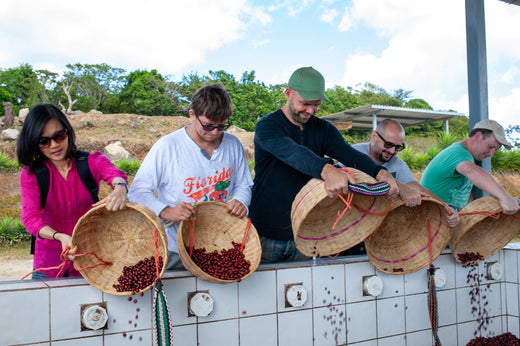Welcome to our annual transparency report for the green coffees that we have bought in 2023. To help you to understand and appreciate the table of numbers better, do spend a few minutes to read through this post.
Price Transparency Highlights:
- Average Price per Pound: We paid an average price of $6.04 per pound for the green coffee beans purchased in 2023.- Price Range: The prices we paid varied depending on the origin, quality, and specific agreements with the producers. Prices ranged from US$3.25 to US$20.06 per pound.
- Direct Trade: A significant portion of our purchases in 2023 were made through direct trade relationships, where we work directly with coffee producers. This direct relationship allows us to understand better what their challenges are and how we can help to keep the business sustainable.
- Collaborative Partnerships: We continued to strengthen our long term partnerships with producers to have a greater impact to those involved in the supply chain.
- Breakdown of Prices: We try our best to break down the prices that are paid as FOB (Free On Board - price paid for the coffee that are packed in container and ready to be boarded on a ship).
The dynamics of coffee pricing post Covid has been challenging. The ongoing war between Russia and Ukraine, coupled with climate change and urban migration has pushed the cost of coffee production northwards. The Middle East conflict also created unexpected freight challenges as shipping companies had to route over the tip of Africa to avoid Houthis’ attack. Rising cost in fertilizers were already felt back in 2022, but the labour crunch in coffee fields have definitely worsened year on year. Last year, our producers have already felt the challenge in hiring cherry pickers during harvests. This year, during our recent trip to Central America, the problem has exacerbated. We hear stories that about a thousand people try to cross the borders towards United States on a daily basis. Those who manage to settle down in the United States are sending money back to their families in Central America, so those who used to work in coffee farms no longer need to work as they receive income from their family members working in US. We see that the repercussion of this migration is threatening the future of coffee farming. The younger generation see a bleak future in coffee farming, hence there is no desire to continue. For producers who want to continue, with the shortage of labour, it is hard to sustain. We hear of coffee farm owners abandoning the farms as it is impossible to get people to pick the cherries during harvest. As roasters and green coffee buyers, we constantly ask ourselves, what can we do to help mitigate this problem?
By publishing the prices we pay for the green coffees, we hope to create to create awareness amongst consumers and put things into perspective what one pays for a cup of coffee versus what coffee farmers earn from every pound/kg of green coffee they sell to us. Most roasters tend to refer to the C-market price as a reference when they talk about how much more they pay for their green coffees. Breaking the bubble, it’s important to understand that C-pricing is typically the coffee prices that are traded on the New York stock exchange for commodity coffees - coffees that you typically find in huge chains and supermarkets. In 2023, the price has fluctuated from a low of $1.51 to a high of $2.02 before closing the year at $1.83. Based on what we understand from the producers whom we work with, these prices are barely enough to cover the costs for production. Producing for the commodity market at such prices is hardly adequate to commensurate for the costs and the risks they are undertaking to continue coffee farming.
Agriculture is hard, and when one’s livelihood is subject to climate risks, labour crunch and rising costs, will they continue to produce those delicious coffees we enjoy so much? Transparency cannot solve this problem by itself, but it is a movement towards sharing with coffee consumers that we seek to reward producers for the quality that they produce. We understand the risks that they take on their end and attempt to share the risks by paying them a price that is sustainable for them to continue doing what they are doing. But we cannot do this alone, or with the 90+ companies who have signed the transparency pledge and share what they are paying for their coffees. We hope this will spur more companies in the coffee industry to come forward and share what they are paying to the producers. Less talk (or sustainbility-washing) and real action to actually pay more for the coffees that we buy. That’s is the only way to keep quality coffees flowing.
Lastly, this wouldn’t have been possible without the collective support of our customers, subscribers and followers through the years, helping us to do what we are doing and at the same time, allowing us to support our producers in an economical sense. Thank you again and we hope to work hand in hand with our producers and share their fruits of labour in the future.
Jia Min & Dennis
Download the report.
